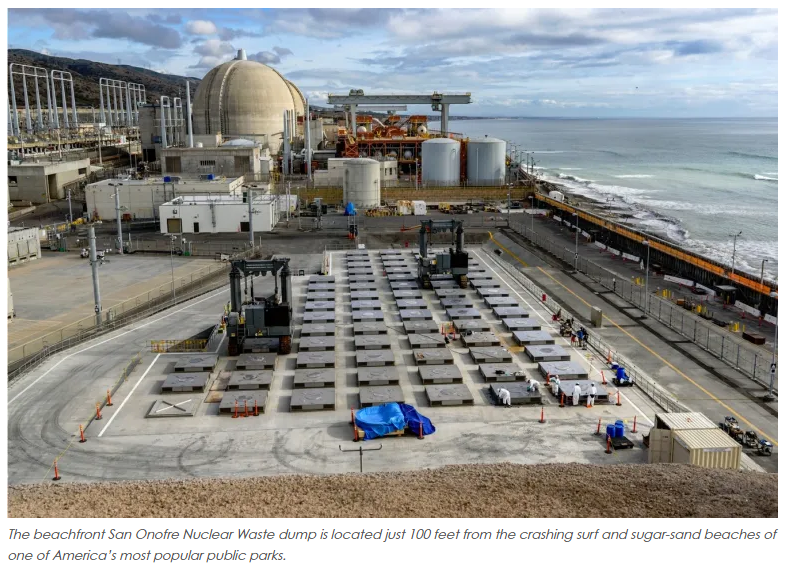Hering and Blanch: Misinformation About Nuclear Waste Does Not Protect the Public’s Safety
August 12, 22
BY LEN HERING AND PAUL BLANCH
On June 6th, 2022, Voice of Orange County published a questionable non-scientifically supported opinion piece by Southern California Edison’s public relations representative, John Dobken. According to Mr. Dobken, the 3.6 million pounds of deadly radioactive waste at the failed San Onofre Nuclear Generating Station (SONGS) is “completely safe.”
Really? Let’s review the facts.
Fact: The radioactive waste at SONGS is stored in thin-walled stainless steel cans that have been lowered into 73 underground storage silos located in concrete pad about 100 feet from the beach. The cans are guaranteed to last 25-years by the manufacturer, but the “spent” fuel inside is deadly for 250,000 years.
Fact: Edison’s credibility has continuously been called into question as far back as 1977 when they were forced to reveal that their vendors installed a 420-ton nuclear reactor vessel backwards (yes, backwards). Confidence was further shattered in January of 2012, when Edison disclosed that its 11-month old replacement equipment had failed and was actively leaking radiation (see ABC news story). In 2018, all remaining trust was shredded when a whistleblower exposed the fact that Edison had lied to the public about a “near-miss” safety incident where a can filled with 50,000 pounds of radioactive nuclear waste was nearly dropped 18 feet inside a storage silo.
Fact: SONGS has the worst safety record of any Nuclear Power plant in the country.
Fact: SONGS is situated on top of so many infamous earthquake faults that early map makers called its location “Earthquake Bay.” More troubling is that, according to a peer-reviewed geological study, SONGS is located in the center of a United States Geological Survey (USGS) tsunami inundation zone.
Fact: The internal temperature of the stainless steel cans can exceed 750 degrees F, hot enough to melt metals such as tin, lead, and zinc. In order for the temperature of the canisters to remain below engineering limits, the heat must be removed by constantly circulating cool air around the outside walls of the canisters. If this airflow is blocked, the cans become dangerously overheated. A major tsunami could block the flow of cool air by packing mud, sand, and organic debris inside the silo.
Fact: As currently designed, it will be impossible to remove that debris quickly, and when this happens, the thin-walled cans will overheat beyond the engineered limit, causing fuel and canister damage.
Fact: If only a few canisters become blocked, the SONGS staff can probably restore cooling, but a tsunami is more likely to impact cooling for all of the 73 underground silos, the above-ground storage bunkers and, more importantly, the recovery infrastructure required to prevent overheating.
The beachfront San Onofre Nuclear Waste dump is located just 100 feet from the crashing surf and sugar-sand beaches of one of America’s most popular public parks.
Fact: The level of effort to restore convection cooling in time to prevent a nuclear disaster given this scenario is enormous. Documents from the Nuclear Regulatory Commission (NRC) show that temperatures inside the cans will increase for eight hours from the time convective cooling stops. The government’s safety analysis stops at eight hours because it fails to consider the above scenario probable and it falsely assumes that all 73 silos might not be affected, and cooling will be restored immediately.
Fact: If all 73 canisters are blocked, recovery can (and will), take weeks if not months. Edison is unprepared because the proper equipment required to respond swiftly has not yet been secured by Edison.
Fact: There is no publicly available analysis showing how long a canister can be blocked before irreversible damage occurs.
Fact: The following are the public safety inquiries that Edison refuses to answer: Can the canisters be cooled before they overheat? Can they be extracted from the silos if mud, sand, and rocks are packed into the sunken annulus area? Will they survive a hot bath in boiling saltwater before corrosion becomes a serious problem? What happens when a canister is breached? Can Edison show the public evidence showing that procedures are in place to recover 73 sizzling hot cans buried under tons of muck, and debris?
Despite all this, Edison’s questionable vendor, Holtec, continues to state that spent fuel storage is “safe” but refuses to answer legitimate safety questions. Asserting that a risk “is not credible” demonstrates a lack of good judgement. Legitimate questions must be answered with legitimate facts, and Edison has failed to do this.
Mr. Dobken’s article attempts to initiate a public dialog, but until the tough questions are answered honestly, the public will remain distrustful. It is only through Edison’s willingness to answer the difficult questions that faith in a true public dialogue and SONGS credibility can be restored.

